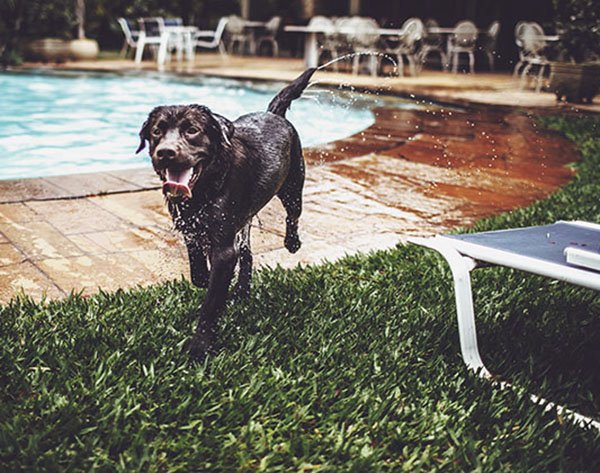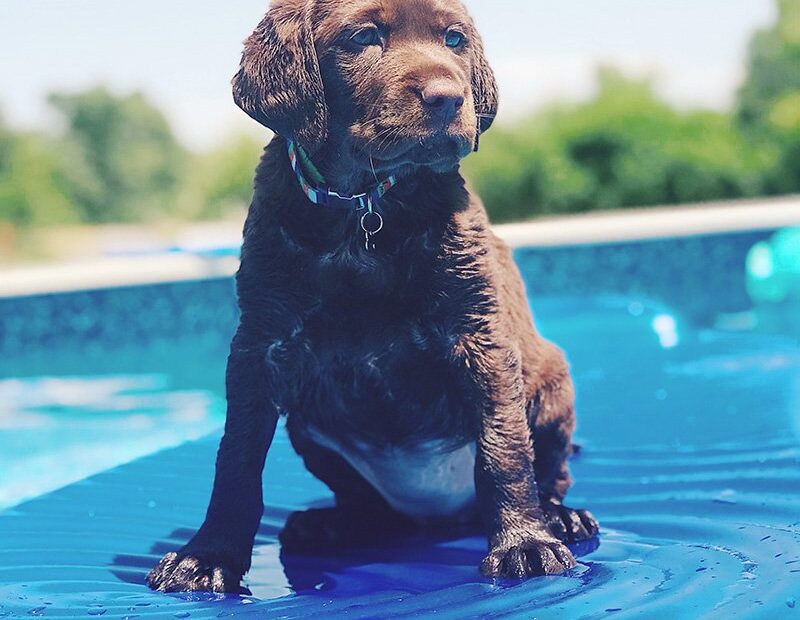As a vet, many people have a whole load of questions they want to ask about looking after their dog. One of the most common things dog owners want to know is how old does a puppy have to be to do something in particular. Many people want to know what age can a puppy go outside. But one of the most sought-after tips in training is how to teach a puppy to swim.
Some people have pools in their back garden, or they go for regular walks with their dog and wonder when is the right time to introduce their puppy to water. Dogs and puppies love to swim and it can be great exercise for strengthening and building muscle in your dog. This form of fitness can take the pressure off of joints which is important for both young puppies who still have delicate tendons and ligaments which are developing. See how your puppy is growing week by week and when your puppy will start to walk for the first time. As they grow older too, dogs will struggle with walking and running, so swimming can be a great form of exercise for senior dogs.

How Soon Can You Teach A Puppy To Swim?
The perfect age to teach a puppy to swim is10 weeks old. No matter what age they are, it is important for your dog that you do not push them beyond their natural capability. Get your puppy used to the water gradually and do not make them fear water. This should make their transition into a water dog a smooth and happy one. Puppies love to play and if you make learning to swim a game, then they will have a great time with you in the pool.
To get your dog learning to swim easily, it is recommended that they wear a life vest at first. This will aid their ability to float in the water and allow them to have fun whilst they are taught the technique of swimming. Expect to see them develop the doggy paddle soon after they are deep enough that their paws can leave the bottom of the water.
Be Prepared to Get Wet!
Dogs are very sociable creatures and they are pack animals by instinct. If your puppy is nervous or uncertain about the water, then get in there with them. They will see you and the rest of the pack having fun and know that it is safe for them to follow you in. This should be a fun activity for you to do with your dog and can help the two of you to bond. Your children can join in too if you have any. Often, I see dogs (especially lab puppies!) who think of themselves as just another member of the family and they will be encouraged that their peers are diving straight in!
How to Introduce Your Dog to Water
The best way to get your dog involved in the water is to take them to a source of water such as a pool, lake, or even the shallow part of the sea or ocean as part of their regular walk. Try and keep things as familiar as possible if you have to travel a significant distance to get to some water.
Start slowly and let your dog investigate the new terrain first. Let them paddle and get their paws wet. As mentioned above, if your dog is reluctant then you should get in with them and give them lots of praise and encouragement. Your dog looks to you fo cues and to know that everything is all right when experiencing something new for the first time.

Take it slowly In The Pool
Build up their confidence slowly and consider a life jacket for dogs to get started off with before you let them plunge in. Puppies can use these to get them started in this form of exercise, but use your best judgment – your puppy may not need one. Let your dog explore and wade out a little deeper when you think they are ready to encourage them to swim. You can try throwing objects such as sticks or their favorite ball or toy which will float to get the puppy started. Play a game of fetch in the water and the pair of you will be having fun in no time. Just remember when your dog is a learner, that you should not push them to swim out too far. This is especially true if there is a current or underwater slipstream that you may not be aware of. Dogs can swim in saltwater pools if you happen to have access to one.
How To Teach A Dog To Swim
You can give your dog swimming lessons wherever there is enough water. I wouldn’t recommend the bathtub as there isn’t sufficient space, even if your dog is quite a small breed. They may not even be able to tread water if the water is not deep enough for them to dive into. Keep the bath for letting your puppy bathe in!
How To Train a Puppy To Swim In A Pool
If you live by the water, such as near a beach, then swimming is a great way to exercise your dog. Many dog breeders and trainers say that owning a puppy that loves to swim is a great way to keep your pet healthy, happy, and active. Many puppies just love the water and you can introduce them to this enjoyable activity very easily. Try searching for dog swimming pools online, they are quite common in more modern areas and do exist in more rural ones as well. If you’re fortunate enough to have access to a pool near you, then introducing your puppy to swimming shouldn’t be too difficult.
To teach your puppy or dog to swim in a pool you must get him used to the water. It is a good idea to get him used to a bathtub or a sink with warm water. This will help him to relax when he is in the water
Put a towel in the pool so he can get used to the feel of the towel on his paws. He will be less likely to slip around.
Do not push him into the pool. Pushing him in will scare him and he will be afraid to go back into the water. It is also a good idea to put a life vest on your pup when he does go in. It will help him to keep his head above water and it will not scare him as much.
Once he is comfortable with the water the next step is to get him to like the feel of the water. To do this you will need to put him in the pool and throw a handful of dog food in the water. Make sure it is dog food that does not sink. If he has to work to get it he will not be afraid of getting into the pool.
After this, you can start to encourage him to swim. Throw the food in the water and tell him to swim to it. You can also throw a toy in the water and encourage him to get it. This will help him to gain confidence in the water and he will begin to enjoy it.
Which Dogs Can Go Swimming?
There are some dogs that cannot swim and therefore should be kept away from large bodies of water. Some dogs do not have the physical capacity to swim based on their size and/or shape. Some types are bred to be a certain shape for other reasons than for physical ability. See the following list for dogs that are unable to swim:
- Dachshund (also known as the Doxie)
- Bassett Hound
- Staffordshire Bull Terrier
- Boxer dogs
- Pekingnese
- Pugs
- Bulldogs
Brachycephalic dogs will struggle in the water. As well as large muscular dogs such as the Rottweiler. In addition, dogs with very thick coats will struggle with buoyancy and floating. These include St Bernards and the Bernese Mountain Dog. These dogs may enjoy the water, such as on a beach, but they may be more likely to have more fun by paddling instead. The same goes for all the other dogs listed above.
Why You Should Train Your Puppy To Swim In Water When They Are Young
Here are three reasons why it is important to get your pup used to the water when they are still small and receptive to learning:
Puppies like to play and swimming is a great way to have fun with them. A swimming puppy will be a safer dog as it teaches them vital life skills.
When you teach your puppy to swim, you are teaching them how to do something mentally challenging and strengthening their mind. Swimming is a great way to exercise and wear your puppy out so they sleep well at night. Puppies learn to trust you, and vice versa.
Swimming is also a great way to socialize. It is a great way to bond with your puppy and strengthen your relationship. You can relax with your dog as it is a fun activity. You should have a higher chance of having a well-rounded dog when you take up this type of activity with them. Swimming is great exercise and is a great way to wear out your puppy in a fun way. The water provides great protection for your dog’s joints whilst training and strengthening their muscles.
One of the best reasons to swim with your puppy is that you can teach them how to get used to the water as they get older. Realizing how to teach a puppy to swim can be a fun and rewarding experience for both you and your puppy. However, it can also be difficult to start training at a young age. One of the most common mistakes made when your puppy is learning to swim is not using the proper swim training aids such as a life jacket. Life jackets provide great protection to young puppies as they learn all about swimming.
The number one question most people ask when considering puppy swimming is when is the best age? There really is no “best” age to train a puppy to swim. Every breed of dog is different, and you want to make sure that you are getting an age that fits their personality. Some breeds swim at a young age, while others need a little bit longer to become accustomed to the water.
Can dogs swim without training?
Yes, dogs can swim without training or being taught how to swim formally. They have a natural instinct in the water. Remember this when you are wanting your puppy to swim. Also, remember which breeds are unable to swim. See the list of dog breeds above for this important safety information.
In Summary
Swimming is an amazing exercise for your dog and you should make an effort to get them excited and relaxed about getting into the water. Most dogs are natural swimmers and can’t wait to get straight in. Others will take a little more encouragement. If your dog is overweight or if it is their first time out, then you should consider a doggy life jacket or vest to get them started. Once they are confident swimmers or have lost some weight, then you can consider taking them out without one.
The most important thing when your puppy is getting swimming lessons is to never give up. It will take some time, especially if you’re trying to teach an older dog, but in the end, it will all be worth it. Teaching your puppy is a learning process just like anything else. Don’t give up, no matter how frustrated you may be. Keep trying and don’t give up until your puppy learns what he’s supposed to do. With enough dedication and patience, you and your puppy will enjoy swimming in no time!
